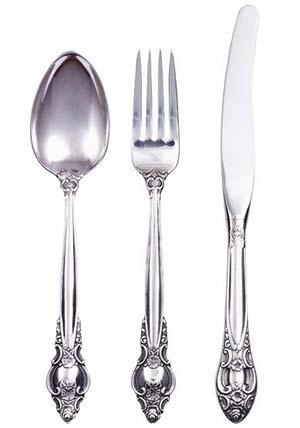Cutlery
Post from EditorialsFeatures, materials, tips on cleaning: everything there is to know to choose the right cutlery and preserve its beauty over time
Cutlery set
The sets of cutlery are composed of a number of covers, typically 6, 12 or 24, all having the same features and decorations and, for each cover, at least seven pieces:
- Knife and fork on the table;
- Knife, fork and spoon fruit for dessert;
- soup spoon;
- Teaspoon.
The ten pieces set, however, also includes:
- Knife and fork for fish;
- Teaspoon.
There are bigger sets that also include a set of knives and then can not miss in the kitchen the cutlery used to cook and serve the dishes:
- Kitchen knives;
- Ladle for broth and short pasta;
- Spoon and long-handled wooden spatula to turn food over the fire;
- Fork for long pasta;
- Steel spatulas for cakes and lasagna;
- Blades with steel colander, round or rectangular, for short pasta ;.
The cutlery can be purchased in packs and gift case, but also alone.
The boxes are very useful for silverware, because the velvet lining protects them from scratches and prevents them from turning black.
In the image above, the beautiful cutlery Santiago by Alessi, the well-known brand always careful to perceive and often create new trends in home fashion 
Another interesting brand, entirely specialized in the design and manufacture of kitchen utensils and tableware, is Serafino Zani that with the set Accent offers a set of silverware cutlery, sleek and refined.
Materials and styles of cutlery
 The cutlery can be realized with various materials; the most used is stainless steel which is rust-proof and with time, unlike the silver plate, does not tarnish.
The cutlery can be realized with various materials; the most used is stainless steel which is rust-proof and with time, unlike the silver plate, does not tarnish.
The best quality is called 18/10 because it contains the 18% of chromium and the 10% of nickel, which ensures its brilliance, once polished.
The silver plate is instead constituted by a metal base, such as nickel, coated with a layer of silver. The thinness of the layer makes, them therefore, less resistant than those in solid silver.
The traditional cutlery have handles of the same metal, in bone or horn; modern ones, however, may have colored handles in plastic or wood.
The cutlery should be chosen in a coordinated style not only with a set of plates, but also with the entire dining room, so that it creates harmony between objects and decorative accessories for the preparation of the table.
The cutlery in classical style, which often reproduce models of the nineteenth century, are quite elaborate shapes with reliefs and decorations on the handle; They are often made of silver or silver plate.
But the classic cutlery also include a variety of models in linear style, that are timeless and also adapt to modern contexts.
The forks have long teeth and very curved, the knives have tapered blades and spoons are oval and slightly sharp.
The designers of the twentieth century have instead followed two lines of thought: some have revisited the traditional cutlery with more current forms; others, have completely revised forms, making them more functional and employing almost always steel.
Handles coated with different materials from the blade are of a relatively recent use.
Usually a metal core is covered with plastic, glossy or matte, or wood with steel rivets or brass.
Those with wooden handle, however, can not be washed in the dishwasher.
Cleaning of the cutlery
The cleaning of the cutlery varies depending on the material they are made with.
The silver cutlery should be washed immediately after use, because prolonged contact with the acids present in foods or eggs makes them darken and dry.
The spots should be removed with special products for silver.
In the case of steel it is simply a washing and only in case of gloss loss you can use the special cleaner for steel.
The gold coating usually does not tarnish and dirt deposits may be removed with specific products.
To clean the handles must be remembered that too hot water can damage the plastic, making it melt or crack. Instead, natural materials such as bone, ivory, horn, but especially wood must not remain too long in contact with water.
To wash this cutlery, dip them in water and detergent, then dry the handles with a soft cloth. Cooking knives can be safely washed in the dishwasher.
The special knives with iron blade, instead, should be washed as soon as possible after use and carefully dried to avoid smearing.
80338 REGISTERED USERS










